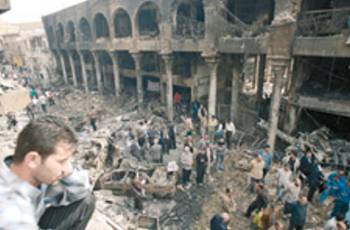
MARCH2007

The Destruction of Matanabbi Street Baghdad, books, bookstalls.
 ..............
..............
In mourning. Iraqi artist, Jabbar Mahyis, put a box on
his head and stood atop the destroyed ceiling of the Ibn
`Arabi printing press on Mutanabbi Street in Baghdad. He
declared the death of cultural life in Baghdad. Light
will not enter, he said.
http://www.angryarab.blogspot.com/
Ethnic Cleansing in the Balkans: Nationalism and the Destruction of Tradition
Book by Cathie Carmichael;
Routledge, 2002
Excerpt from Chapter 1.
The book can be read at http://www.questia.com/PM.qst?a=o&d=102726651
During the 1990s and the Yugoslavian Wars of Dissolution, fought primarily in Kosovo, Bosnia and Croatia, the term ‘ethnic cleansing’ was used in the world media to describe the killing and forcible movement of populations deemed to be different on the grounds of their ethnicity, religion or language. It soon entered the standard vocabulary of the English and other languages, but its usage often appears to be both euphemistic and imprecise. This book is an attempt to define what this term might actually mean and to place the events surrounding the practice of ethnic cleansing in a wider geographical and historical context.
In attempting to define ethnic cleansing what is presented here is a study of the impact of nationalism, 1 the formation of new states and the destruction of existing cultures and communities in the region of Europe 2 often referred to as the Balkans. 3 If we accept this term ‘Balkans’ 4 as being ‘tantamount to the Ottoman legacy’ 5 in Europe then this geographical term would cover the regions of contemporary Albania, Macedonia, Greece, the Krajina region of Croatia, 6 Serbia, Bulgaria, European Turkey, Montenegro, Bosnia-Hercegovina and Kosovo (and some elements in the historical legacies of Austria, Hungary, Romania and Slovenia). Here we explore some of the reasons why these regions experienced such violent and destructive fratricidal struggles over the last two hundred years and question as to why people deemed to be alien within the new states have been murdered or expelled from the regions they have inhabited for centuries. Throughout the text, the Balkans has been defined as a single historical region and instances of ethnic cleansing as a series of related historical events. This is largely because I have interpreted the origins of the practice of ethnic cleansing as almost entirely ideological. It is not my intention to detract from studies that have focused on single regions or instances of ethnic cleansing or even theses that present these as unrelated phenomena. This study can only be a contribution to an important scholarly and ethical debate that may never be resolved with a single answer, because ultimately what we are dealing with here is the lives of many millions of people, whose own responses to circumstances may be qualitatively different. What the historian can legitimately try to do, however, is to discern if patterns of behaviour have developed over time, while still recognizing the role of the individual.
Every case of ethnically inspired murder is unlike any other in important ways, but what interests me here primarily is how and why these events might be deemed to constitute a single phenomenon.
During the last few hundred years, many parts of Europe (and indeed, regions of the globe other colonized by Europeans) have experienced ethnically inspired violence in the wake of state formation which has destroyed, unsettled or damaged older cultures. As a phenomenon it is certainly not restricted to the South East of Europe, nor indeed, as argued in the following chapters, did the ideas that triggered outbreaks of violence even originate there. The extermination of over 90 per cent of Poland’s Jews in the early 1940s; the Highland clearances in Scotland in the eighteenth century; the expulsion of ethnic Germans from postwar Czechoslovakia; the transportation of the Crimean Tartars in 1941; the slaughter of Izmir’s Greeks and Armenians in the early 1920s; and the exodus of Muslims from the Balkans after the mid-nineteenth century are only a few of the numerous instances of this kind of violence.
Ethnic cleansing has become a broad term, 7 which covers all forms of ethnically inspired violence from murder, rape and torture to forceful removal of populations. In 1993, a United Nations Commission of experts reported to the Security Council that ethnic cleansing involved ‘the planned deliberate removal from a specific territory, persons of a particular ethnic group, by force or intimidation, in order to render that area ethnically homogeneous’. 8 As Norman Naimark has stated ‘ethnic cleansing bleeds into genocide’, suggesting a continuum between the phenomena, and at the present time ethnic cleansing is taking on ‘a juridical meaning through the war crimes courts in the Hague, just as genocide was defined by Article II of the United Nations Convention on the Prevention and Punishment of the Crime of Genocide of December 9, 1948’. 9 As Ahmed Akbar has remarked, it has become a ‘metaphor for our time’ 10 and ‘ethnic cleansing’ or similar constructions such as the ‘cleansing of terrain’ was certainly used in the former Yugoslavia in the 1980s and 1990s, drawing on older similar terms by nationalist writers and ideologues. At the Hague Tribunal, Paul Garde described ethnic cleansing as
a practice which means you act in such a way that, in a given territory, the members of a given ethnic group are eliminated, with the aim that the territory be ‘ethnically pure’, in other words that it would contain only members of the ethnic group that took the initiative of cleansing the territory. 11
The perpetrators of such violence are usually clear about their objectives, characteristically constructing the nation in unambiguous terms and anxious to exclude ‘non-nationals’ and potentially disloyal ‘minorities’. The removal of existing populations has clear material benefits for some of those who carry it out: supporters of the regime in postwar Yugoslavia moved into comfortable Slavonian and Istrian homes of the Germans and Italians that they had driven out, creating a ‘web of complicity’ 12 between themselves and the Communists. This process of appropriation of property occurs continually throughout the period under consideration. Sometimes exchanges have been carried out with a kind of dreadful ‘symmetry’: in 1995, displaced Croats from Banja Luka in Republika Srpska moved into newly vacated homes in Knin in Croatia previously inhabited by Serbs.
Despite the material advantages to be had from seizing the property of others, the roots of the practice of ethnic cleansing, it is argued here, are more closely tied to ideology. If ethnic cleansing was primarily about greed or a kind of class hatred for those in the community that have better homes or more goods, it is unlikely that it would manifest itself as violence against an ethnic group per se. This kind of violence, directed against ethnic communities during times of crisis, has both religious and nationalist origins in European thought and political practice. Christian intolerance of other religions (and of Christians of other denominations in the world of Orthodox/Catholic schism) dates back to before the Middle Ages and was manifested in the Crusades, the persecution of Jews, of Muslims and of religious radicals and heretics, such as Cathars and Anabaptists. 13 From the eighteenth century onwards, consciousness of biological ‘race’, notions of linguistic fraternity, state-orientated loyalties - the elements that combined to create the ideology generally referred to as nationalism - combined with older prejudices to create the conditions which led to an almost perpetual intolerance of cultural and ethnic diversity and polytaxis (multiple taxonomy or self-identification) in the minds of many Europeans.
Ethnically inspired violence is certainly an integral element of European culture, yet at the same time Europe has also been a home to tolerant cultures, where ethnocentrism is confined to the very edges of society, even if it is not fully eliminated. The zest of ethnic mix in towns like Trieste, Vienna, London, Dublin, Salonika, Paris, Sarajevo or Amsterdam has produced great human achievements and demonstrated that diversity or polytaxis are plausible alternatives to ethnic monoliths. Roy Gutman believes that the old ‘Sarajevo with its skyline of minarets, church steeples and synagogues was a testimony to centuries of civilized multiethnic coexistence. It was a place of learning and of commerce: … a European jewel.’ 14 Although multiethnicity is frequently constructed as a source of structural weakness in the case of the Balkans, it is rarely seen as a weakness when examining contemporary Switzerland or Great Britain.
The interpretation of texts
This book has been written as a form of histoire-problème, in the sense that the term was used by the French Annales school of historians. 15 In effect, adopting this approach has meant examining ethnic cleansing in the Balkans as a single historical phenomenon or series of phenomena related first and foremost to the spread of nationalist ideas and the collapse of the hegemony of the Ottomans and then subsequently the Habsburgs in this region and the competitions of various state projects that competed to replace this hegemony in the region. As Lucien Febvre once said ‘to pose a problem is precisely the beginning and the end of all history. No problems, no history.’ 16 The ‘problem’ that we encounter here is that nationalism as an ideology effectively destroyed alternatives. In the following chapters, I explore some of the reasons why the adherence to the idea of the single nation as opposed to other forms of collectivity was so powerful and in intellectual terms so paradigmatic from the end of the eighteenth century. Its advocates eventually destroyed all the alternatives to nation states: the Ottoman Empire, the Habsburg Monarchy, Royalist Yugoslavia 17 and then in the 1990s the Federal Republic of Yugoslavia. While some of the contemporary Balkan states claim to be Ethno-Federations, at the beginning of the twenty-first century they are certainly far less ethnically mixed than they would have been had population movement and ethnic cleansing not taken place.
Initially, I assumed that the actions of individuals during times of war and ethnic cleansing could be interpreted hermeneutically and that by studying first hand accounts of ethnic cleansing and the atrocities that went with them a great deal about the phenomenon itself would be revealed. Thus, the closer 18 that one could get to the original event, the nearer one would be to understanding what actually took place and why. This approach reveals not only the influence of the French historical school, but of the cultural anthropology of Clifford Geertz, which has proved very influential among historians attempting to decode and interpret past events. Geertz examined single ‘events’ or ‘texts’ (most famously cock fighting in Bali) in order to try and discover how certain actions, symbols and signs might convey meaning about the culture that he was describing. 19 The approach of Geertz has been highly influential among historians of popular culture in Europe, including Robert Darnton and Natalie Zemon Davis particularly when examining and decoding pre-modern cultures.
http://www.questia.com/PM.qst?a=o&d=102726651